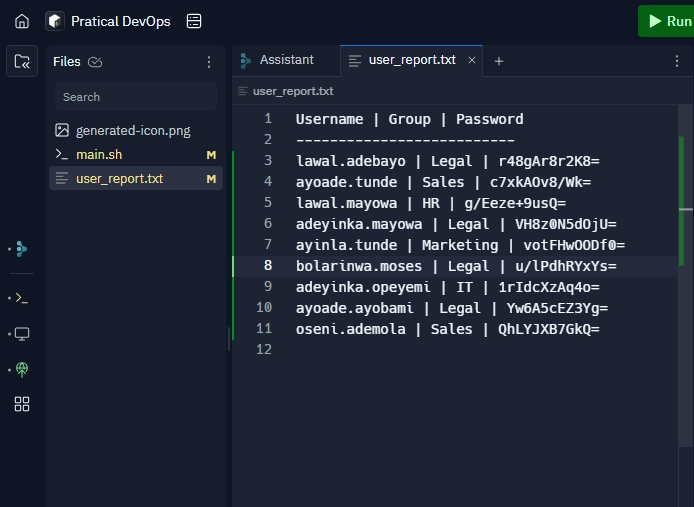Automating Grocery Lists with Notion and Telegram
TL;DR Managing grocery lists manually was chaotic, so I automated the process using Notion and a Telegram bot. A TypeScript script connects to Notion’s API, gathers ingredients from selected recipes, and creates a shopping list automatically. The bot allows me to generate lists and mark items as purchased with simple commands. Introduction My partner and I recently decided to eat healthier, which meant cooking more at home. She shared several recipe links, but when I went grocery shopping, I realized managing ingredients manually was overwhelming. Jumping between recipe links while trying to buy everything efficiently was frustrating. That’s when I had an idea: automate the whole process! The Notion Setup To keep track of everything, I used Notion, where we already manage household tasks. I created several databases: Ingredients – A list of all the ingredients we might need. Recipes – Each recipe links to the necessary ingredients. Shopping Lists – A database where each entry represents a shopping trip, containing a to-do list of ingredients to buy. This setup made organizing ingredients easier, but I still had to manually transfer them from recipes to the shopping list. Not efficient enough! Automating with TypeScript and Notion’s API To fully automate the process, I wrote a TypeScript script that connects to Notion’s API. Here’s what it does: 1- Scans all recipes where a specific checkbox is enabled. async function getRecipesToAdd() { const response = await notion.databases.query({ database_id: RECIPES_DB_ID, // Your notion db ID, you can grab it from the url filter: { property: "Add to list?", // The checkbox we manually enable if we want recipes to be processed checkbox: { equals: true, }, }, }); return response.results; } 2- Extracts the required ingredients. async function getIngredientsList(recipePage) { const relationArray = recipePage.properties["Ingredients"]?.relation; if (!relationArray || !relationArray.length) { return []; } const ingredientNames = []; for (const rel of relationArray) { const ingredientPageId = rel.id; const ingredientPage = await notion.pages.retrieve({ page_id: ingredientPageId, }); const nameProp = (ingredientPage as PageObjectResponse).properties[ "Ingredient" ]; let ingredientName = "Unnamed Ingredient"; if ( nameProp && isTitleProperty(nameProp) && nameProp.title && nameProp.title[0] ) { ingredientName = nameProp.title[0].plain_text; } ingredientNames.push(ingredientName); } return ingredientNames; } 3- Creates a new shopping list. async function createShoppingListPage() { const todayStr = new Date().toISOString().slice(0, 10); const pageName = `Nueva lista ${todayStr}`; return await notion.pages.create({ parent: { database_id: SHOPPING_LISTS_DB_ID }, properties: { Name: { title: [{ type: "text", text: { content: pageName } }], }, Fecha: { date: { start: todayStr }, }, Comprado: { checkbox: false, }, }, }); } 4- Populate the page with ingredients, we are going to use to-do blocks async function appendIngredientChecklist(pageId, ingredients) { const children = ingredients.map((item) => ({ object: "block", type: "to_do", to_do: { rich_text: [ { type: "text", text: { content: item }, }, ], checked: false, }, })); await notion.blocks.children.append({ block_id: pageId, children, }); } This meant that with a simple selection of recipes, my shopping list would be generated instantly. Running the Script via Telegram I didn’t want to manually run the script on my computer every time, so I integrated it with Telegram: I built a Telegram bot using telegraf, that triggers the script with a command. The bot automatically compiles the grocery list inside Notion. bot.command("import", async (ctx) => { const isValid = await checkUserValid(ctx.from.username, ctx); // Just a check making sure my partner and I are the only ones allowed to use certain commands if (!isValid) { return; } await ctx.reply("Importing ingredients..."); return buildShoppingList(ctx); }); A second command lists pending shopping lists. export async function listShoppingLists(context: Context) { await context.reply("Loading shopping list..."); const response = await notion.databases.query({ database_id: process.env.SHOPPING_LIST_DB_ID, filter: { property: "Bought", checkbox: { equals: false, }, }, }); if (response.results.length > 0) { await context.reply( `${context.from.first_name}, elements pending to buy:`, ); } else { return context.reply("No elements to add."); } for (const p

TL;DR
Managing grocery lists manually was chaotic, so I automated the process using Notion and a Telegram bot. A TypeScript script connects to Notion’s API, gathers ingredients from selected recipes, and creates a shopping list automatically. The bot allows me to generate lists and mark items as purchased with simple commands.
Introduction
My partner and I recently decided to eat healthier, which meant cooking more at home. She shared several recipe links, but when I went grocery shopping, I realized managing ingredients manually was overwhelming. Jumping between recipe links while trying to buy everything efficiently was frustrating.
That’s when I had an idea: automate the whole process!
The Notion Setup
To keep track of everything, I used Notion, where we already manage household tasks. I created several databases:
- Ingredients – A list of all the ingredients we might need.
- Recipes – Each recipe links to the necessary ingredients.
- Shopping Lists – A database where each entry represents a shopping trip, containing a to-do list of ingredients to buy.
This setup made organizing ingredients easier, but I still had to manually transfer them from recipes to the shopping list. Not efficient enough!
Automating with TypeScript and Notion’s API
To fully automate the process, I wrote a TypeScript script that connects to Notion’s API. Here’s what it does:
1- Scans all recipes where a specific checkbox is enabled.
async function getRecipesToAdd() {
const response = await notion.databases.query({
database_id: RECIPES_DB_ID, // Your notion db ID, you can grab it from the url
filter: {
property: "Add to list?", // The checkbox we manually enable if we want recipes to be processed
checkbox: {
equals: true,
},
},
});
return response.results;
}
2- Extracts the required ingredients.
async function getIngredientsList(recipePage) {
const relationArray = recipePage.properties["Ingredients"]?.relation;
if (!relationArray || !relationArray.length) {
return [];
}
const ingredientNames = [];
for (const rel of relationArray) {
const ingredientPageId = rel.id;
const ingredientPage = await notion.pages.retrieve({
page_id: ingredientPageId,
});
const nameProp = (ingredientPage as PageObjectResponse).properties[
"Ingredient"
];
let ingredientName = "Unnamed Ingredient";
if (
nameProp &&
isTitleProperty(nameProp) &&
nameProp.title &&
nameProp.title[0]
) {
ingredientName = nameProp.title[0].plain_text;
}
ingredientNames.push(ingredientName);
}
return ingredientNames;
}
3- Creates a new shopping list.
async function createShoppingListPage() {
const todayStr = new Date().toISOString().slice(0, 10);
const pageName = `Nueva lista ${todayStr}`;
return await notion.pages.create({
parent: { database_id: SHOPPING_LISTS_DB_ID },
properties: {
Name: {
title: [{ type: "text", text: { content: pageName } }],
},
Fecha: {
date: { start: todayStr },
},
Comprado: {
checkbox: false,
},
},
});
}
4- Populate the page with ingredients, we are going to use to-do blocks
async function appendIngredientChecklist(pageId, ingredients) {
const children = ingredients.map((item) => ({
object: "block",
type: "to_do",
to_do: {
rich_text: [
{
type: "text",
text: { content: item },
},
],
checked: false,
},
}));
await notion.blocks.children.append({
block_id: pageId,
children,
});
}
This meant that with a simple selection of recipes, my shopping list would be generated instantly.
Running the Script via Telegram
I didn’t want to manually run the script on my computer every time, so I integrated it with Telegram:
- I built a Telegram bot using telegraf, that triggers the script with a command.
- The bot automatically compiles the grocery list inside Notion.
bot.command("import", async (ctx) => {
const isValid = await checkUserValid(ctx.from.username, ctx); // Just a check making sure my partner and I are the only ones allowed to use certain commands
if (!isValid) {
return;
}
await ctx.reply("Importing ingredients...");
return buildShoppingList(ctx);
});
- A second command lists pending shopping lists.
export async function listShoppingLists(context: Context) {
await context.reply("Loading shopping list...");
const response = await notion.databases.query({
database_id: process.env.SHOPPING_LIST_DB_ID,
filter: {
property: "Bought",
checkbox: {
equals: false,
},
},
});
if (response.results.length > 0) {
await context.reply(
`${context.from.first_name}, elements pending to buy:`,
);
} else {
return context.reply("No elements to add.");
}
for (const page of response.results) {
const allIngredients: string[] = [];
const ingredients = await notion.blocks.children.list({
block_id: page.id,
});
allIngredients.push(
...ingredients.results
.map((ingredient: BlockObjectResponse) => {
if (ingredient.type === "to_do") {
const checked = ingredient.to_do.checked ? "✅" : " 








































































































































































![[The AI Show Episode 142]: ChatGPT’s New Image Generator, Studio Ghibli Craze and Backlash, Gemini 2.5, OpenAI Academy, 4o Updates, Vibe Marketing & xAI Acquires X](https://www.marketingaiinstitute.com/hubfs/ep%20142%20cover.png)


























































































































![[FREE EBOOKS] The Kubernetes Bible, The Ultimate Linux Shell Scripting Guide & Four More Best Selling Titles](https://www.javacodegeeks.com/wp-content/uploads/2012/12/jcg-logo.jpg)



![From drop-out to software architect with Jason Lengstorf [Podcast #167]](https://cdn.hashnode.com/res/hashnode/image/upload/v1743796461357/f3d19cd7-e6f5-4d7c-8bfc-eb974bc8da68.png?#)







































































































.png?#)




.jpg?#)


















 (1).webp?#)













_Christophe_Coat_Alamy.jpg?#)







































































































![Rapidus in Talks With Apple as It Accelerates Toward 2nm Chip Production [Report]](https://www.iclarified.com/images/news/96937/96937/96937-640.jpg)









































































































































